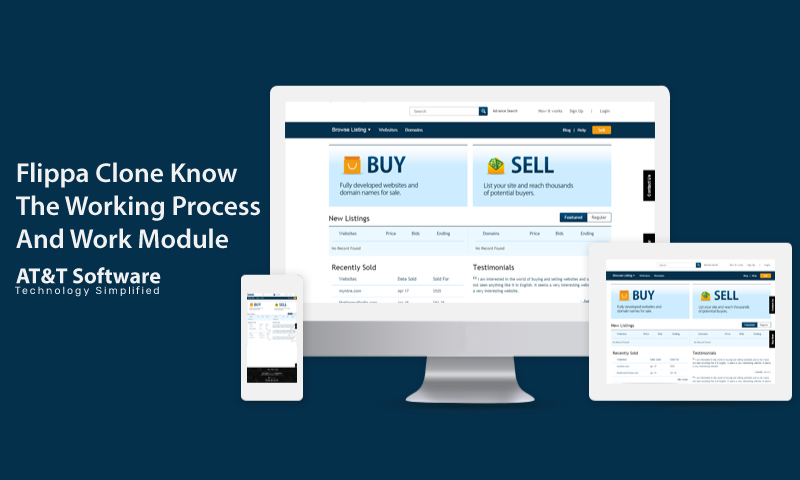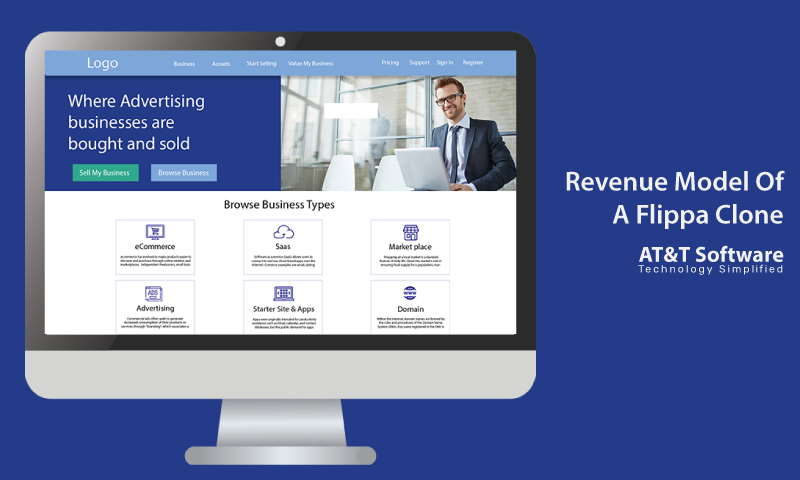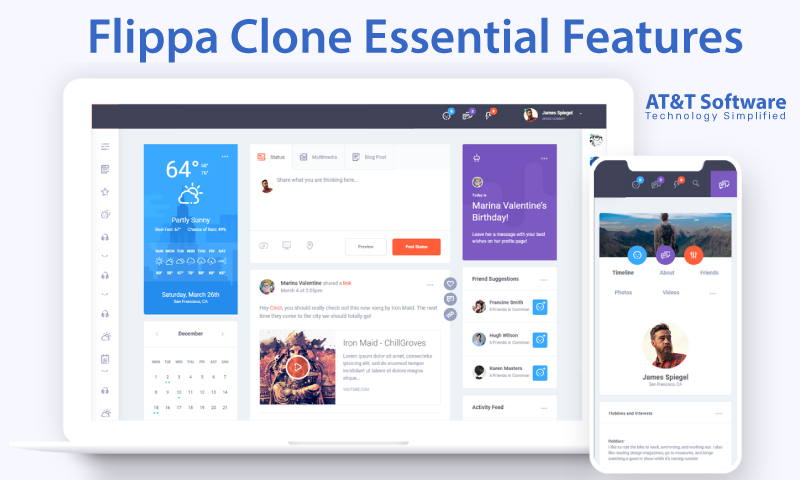Flippa Clone- Know The Working Process And Work Module
home / blog / Flippa Clone- Know The Working Process And Work Module

The growth of online marketplaces for buying and selling websites like Flippa Clone has a lot of potential from a business sense. Web platforms are essential in the era of digitalization and the internet. Today, every other business platform has its online outlet to build and manage its online presence.
Businesses can sell their established web platform to buyers interested in the deal in an online website buying-selling marketplace. They can negotiate about different aspects of the platform, the price, and other things related to the trade. While buying and selling websites can still be easier with a marketplace, building an online marketplace requires more than just ideation.
However, ideation is still essential. You have first to be able to visualize how the Flippa Clone is supposed to function. Once you do so, you can then move on with that idea and add further things like features and revenue models. Finally, if everything went well and executed correctly, you have your online buying-selling marketplace ready for launch. So, let us start with the workflow of the buyer and the seller.
Buyerś Workflow:
- Buyers will initially need to register or log in.
- Once they have logged in, they can look through the platform for available items. The app will automatically recommend a few options for the buyer to look into.
- The buyer can also search for specific websites that are up for sale or something close to the parameter. In addition, there are different filters made available by the app platform.
- If they come across any website that precisely suits their requirements, they can look into the details, negotiate the deal and find the best possible route for bidding for the website.
- Lastly, the buyer of a Flippa Clone will have to patiently wait for the seller to come around with an agreement to complete a trade.
Vendorś Workflow:
- The vendor or seller will have to register and often verify their identity.
- Once they have successfully logged into their account, they can create their profiles. They can add crucial info about themselves and their organization for the sellers to have a clear look into the sellerś previous works and deals.
- They can add the product, or in this case, an established website, up for sale. Then, they can add all the details, offers, and other relevant info.
- If a buyer shows interest in the product, they can bid for it. And, if the bid gets approved on sides, then the deal gets confirmed. The Flippa Clone processes the transaction, and the seller gets his due on time without much hassle.
Revenue Model Of A Flippa Clone

The platform hosts both buyers and sellers under its wing for doing business. However, it needs to do business of its own to make revenue and survive in the market. There are a few revenue models devised based on the app’s workflow. The revenue model is constructed and infused between different parts of the workflow. Let us check the different ways a Flippa Clone can earn revenue.
Commission Revenue
Every app platform has some way of including commissions through its services. Such a platform can earn commission from the buyer and the seller. There can be a certain percentage set up by the platform initially, and it will be inscribed under their policy sections for all to know.
Listing Fee
Apart from the commissions earned, the platform can collect revenue on other grounds. For example, whenever sellers list a product on the marketplace, they have to pay a certain amount to the app. This can be charged according to individual product, or the platform could have a periodical payment system for having their product out for sale on the platform for a certain time. After which, they might have to renew it for some more time if the product has not been already sold out.
Promotional Fee
Along with adding a product to the list, the seller may want to highlight their product. For getting a better reach and visibility of their product, the seller can choose to promote their content. In addition, they can pay to achieve this feat. In this case, the Flippa Clone receives a direct payment from the seller for promoting their product and ensuring a better sale opportunity.
Ad Revenue Model
Probably, the best way to earn direct revenue is from third-party advertisements. The app deliberately saves up strategic space on its app platform, which will be lent out to third-party web portals. The third-party website or application will pay for leasing a particular space for posting their ads for a specific period. There is also a renewal option for third-party applications to extend the time.
Flippa Clone Essential Features

The features ensued on a Flippa Clone are intricately connected to buying and selling website ownerships through the marketplace and making a business out of it. The features listed below are the most essential for the platform. In addition, there will be separate features for buyers, sellers, and admins that are most crucial for the platform to continue its services.
User Registration & Login
Both the buyer and the seller will have to register to the platform to buy or sell things using the marketplace. The registration process is similar for both parties to some extent. They will have sign-up initially using their email I.D or social media credentials. From here, the process gets a bit complex for the seller. They might have to get verified some documentation and prove their authenticity.
Interactive User Dashboard
The user is equipped with an interactive user dashboard on a Flippa Clone, whether the buyer or the seller. The dashboard is similar for both panels, consisting of features from both sides. So, the seller finds important options for selling their website, and the buyer can look for the best bet available. In addition, they can customize the dashboard to their requirement.
Advanced Admin Dashboard
Similarly, the admin is also allotted an advanced admin dashboard. The admin dashboard is entirely different from the user dashboard in terms of features and functionality. The functions of an admin include looking over the platform, managing the activities and transactions, and driving a significant revenue percentage homewards. Thus, the features on the admin dashboard are also reflective of the functions of the panel.
Auction Management
Every buying-selling bid on a Flippa Clone is managed efficiently by the platform. As soon as the product is listed on the platform, interested buyers become eligible for bids to acquire the domain, website, or application sold by the seller. The auction may have its rules and limits, which both parties will be sworn by.
Private Messaging
Once the bid starts, like in actual auction events, different parties are allowed to have an open conversation. This is offered through chatting and private messaging. While open forums for bidding are one of the traditional methods, an online website buying-selling marketplace also includes private messaging. By privately contacting the seller, the buyer has a chance of negotiating and presenting their case, and if they can convince the seller, there remains no need for a public auction event.
User Management
As the app admin is rested with the responsibility of managing the whole platform, it includes user management. We mean the adminś ability to contain or exclude users going the rules and policies by user management.
Website Verification
As the admin has the power of dictating who gets to join the platform and who gets to leave, the Flippa Clone gives the admin the power to look after the matter. Thus, every time a registration request is lodged, the admin can verify the seller’s and buyers’ credentials, documents, and data. They also need to verify the websites listed by sellers and scrutinize any false or fake claims made by the seller to get a better deal.
Multi-Payment Gateway
The app platform has a multi-payment gateway to allow users access to different options. These alternatives are essential for both parties, especially the buyer, as they can choose from other options if one fails.
SEO Friendly
The Flippa Clone has to include a few SEO-friendly features that will help the app boost its visibility among people interested in the matter. These SEO-friendly options are significant in todayś time for consistently maintaining the app image and the appś online presence.
Social Media Integration
Allowing users to log in using their social media credentials can only be made possible with social media integration. Furthermore, social media integration has provided a positive outcome with increased online shares and an undeniable presence.
Multi-Level Category
A Flippa Clone can wisely include a multi-level category. A multi-level category is more organized as its places specific content under specific sections. This way, it becomes easier for buyers to find and locate products faster.
Multi-Language
As a marketplace hosting people from all over the globe buying and selling websites, domains, and other things, it must allow users to have constructive conversations. But unfortunately, this cannot happen if there are language barriers. For this reason, it has become incessantly necessary for global platforms to include multi-language features so that each user can have their fair share in the game.
Daily Deals
The app could also include daily deals that will regularly attract buyers to get back to the app. Both sellers and admins present these deals on specific items, mostly which are being promoted.
Conclusion

We have listed down a few things you need to know to develop a Flippa Clone. Workflow, revenue plan, and features are the backbone of any app development, especially clones. If everything is lined up right, the app development process can be interesting.

I hope you enjoy reading this blog post.
Would you like to get expert advice? Schedule a Call
About Webrock Media
Webrock Media comes with an incredible team of website and mobile application developers who can customize the perfect solutions to transform your business. We think ourselves to be an ideal ‘Technology Simplified Destination’ as we know how to perfectly merge creativity and programming to build robust websites for our clients.
